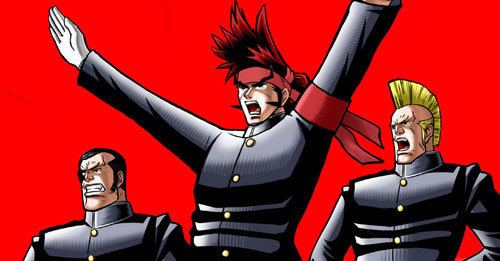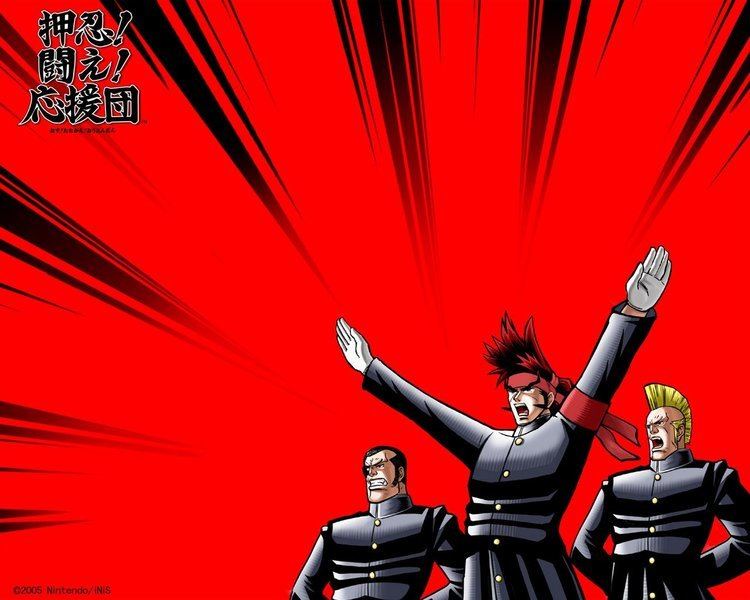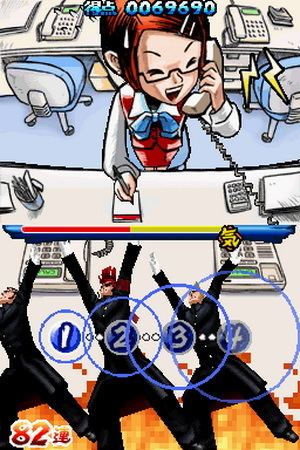10 /10 1 Votes10
Designer(s) Keiichi Yano Developer iNiS | 5/5 eBay Initial release date 28 July 2005 Director Keiichi Yano | |||||||||||||||||||||||||||||||||
 | ||||||||||||||||||||||||||||||||||
Similar Music video games, Other games | ||||||||||||||||||||||||||||||||||
Osu tatakae ouendan 2 countdown super hard s rank hq 60 fps
Osu! Tatakae! Ouendan (押忍!闘え!応援団, Osu! Tatakae! Ōendan, translated as "Go! Fight! Cheer Squad"), or simply Ouendan, is a rhythm video game developed by iNiS and published by Nintendo for the Nintendo DS handheld game console in 2005, for release only in Japan. Ouendan stars a cheer squad rhythmically cheering for various troubled people, presented in game in the style of a manga comic. In each stage, players use the DS touchscreen to tap specifically marked spots that appear in rhythm to various Japanese pop songs, scoring points for accurate timing and avoiding a poor performance which can cause the stage to end prematurely. Though never released in Western markets, it was a popular import to these regions, leading to the development of the Westernized spiritual sequel Elite Beat Agents, as well as a direct Japanese sequel Moero! Nekketsu Rhythm Damashii Osu! Tatakae! Ouendan 2.
Contents
- Osu tatakae ouendan 2 countdown super hard s rank hq 60 fps
- Osu tatakae ouendan main trailer
- Gameplay
- Plot
- Development
- Reception
- Sequels
- Track listing
- References

Osu tatakae ouendan main trailer
Gameplay
Each level of Ouendan features a plot line accompanied by a specific song. A character (or characters) facing a problem will cry Ouendan! (応援団) when their conflict reaches a climax. This call summons the cheer squad, and the song starts. During the game, the story is told on the Nintendo DS's top screen, and gameplay takes place on the touch screen. The player uses the Nintendo DS's stylus to perform varying actions according to the markers that appear on screen:

Depending on how precise the player's actions are, he or she will either be awarded 50, 100, or 300 points. There is a life bar that represents the character or characters' fighting spirit that constantly drains over the course of the song, but can be refilled with hitting the indicated beats; the more precise the player is, the more energy is restored. However, if the player should miss a beat completely, the meter will deplete even further. If the life bar should empty, the level will end, resulting in failure for the character. To advance in the game, each stage must be completed successfully. The game saves progress automatically once a stage has been completed.

Within each stage are two to four break points where the player can take a rest while a scene from the story plays out on the top screen. If the life meter is at least fifty percent filled and in the yellow, the scene will depict a positive result such as, in the case of the pottery maker, gaining great inspiration for a new work. If the life meter is less than fifty percent full and in the red, the resulting scene will depict the character encountering a setback, such as the pottery master coming up with yet another drab creation.

The score for each level is based on the timing of the beats, and the current number of beats made in a row, which increases the combo multiplier by 1x each time. Thus, for example, after completing 50 beats in a row successfully, the multiplier will be at 50x. After completing any song, the player can go back and attempt to improve the score for that song. Additionally, as a combo grows, flames will appear behind the cheer squad, and the longer the combo is maintained, the taller the flames will rise until reaching the top of the touch screen. The flames will disappear completely if the combo is broken. The use of flames is constant throughout the game to represent the protagonist's determination.

There are four difficulty levels in the game. Initially, only Easy mode (気軽, kigaru, "light-heartedly cheer") and Normal mode (果敢, kakan, "boldly cheer") are available, but completing Normal mode will unlock Hard mode (激烈, gekiretsu, "fervently cheer"), and completing Hard mode will unlock Very Hard/Insane mode (華麗, karei, "gracefully cheer"). Each mode uses a different cheer team leader, with the exception of Very Hard/Insane Mode, which changes the whole team into a team of 3 cheerleader girls.
Increasing the difficulty level generally increases the number of markers to hit, the rate at which markers appear, and the rate at which the life bar depletes. Very Hard mode is basically Hard mode rotated 180 degrees, with markers being smaller and appearing faster, thus allowing less response time. However, there are subtle differences, such as extra markers for short double beats and different, more complex, beats for some songs.
Plot
Ouendan details the plight of several characters in hopeless situations who cry out for help. In response, the Ouendan, an all-male cheer squad appear to help each character work through their problems by cheering them through music. The origin of the Ouendan is unexplained in the game, though they are always nearby when help is needed. The Ouendan appear wearing highly stylized black uniforms (based on gaku-ran Japanese school uniforms) with red armbands, a common sight at Japanese school sporting events.
Most of the scenarios are inspired by modern Japanese culture, or are heavily influenced by the Japanese form of print comics, or manga. For instance, the first stage features a high school student distracted from studying for his college entrance exams by his family, while a later stage focuses on a pottery master who has lost the inspiration to create unique works. Most of the stories are presented in a light-hearted or comical fashion, emphasized by absurd storyline twists and the sounds of whistles and cheer shouts as the player progresses through each stage. The one notable exception to this is a love story set to the song "Over the Distance," which is told in a more heartfelt, subdued tone further marked by the gameplay's whistle sound effect being replaced with subtle chimes and the initial loud countdown not being used.
While the individual stories otherwise have no connecting theme to them, characters from some stories reappear in others as background figures or supporting characters. However, all of the characters reappear in the final story, in which the Ouendan must lead the entire world in a cheer to save Earth from being destroyed by an asteroid.
Development
At the 2007 Game Developers Conference in San Francisco, iNiS Vice President Keiichi Yano described the process which eventually resulted in Osu! Tatakae! Ouendan. His first inspirations for the game came when he first tried a Nintendo DS handheld, and development on the game began after successfully pitching the concept to Nintendo. At the conference, he also displayed early concept art for lead Ouendan character Ryūta Ippongi, who originally wore the shirt of his gaku-ran uniform unbuttoned and had a significantly shorter hairstyle. Yano noted that Nintendo was fond of the characters due to their manga-style aesthetic.
Yano also displayed an unused Ouendan stage from a prototype build that featured a puppy in danger. The stage concept was ultimately dropped from the final version of the game because the puppy died if the player failed the stage.
The music used in Ouendan consists of hit songs by well-known J-pop artists. The majority are taken from the mid-to-late 1990s and early 2000s, though The Blue Hearts' "Linda Linda" and Linda Yamamoto's "Neraiuchi" date from 1987 and 1973, respectively. All of the recordings featured in the game, besides 175R's "Melody" (which also plays over the game's end credits) are covers, rather than recordings by the original artists.
Reception
Some news sources, such as GameCentral on Channel 4's Teletext service in the UK, gave it positive coverage, leading to the game becoming something of a cult hit among gamers who were prepared to import it.
In December 2006, Press Start Online placed Ouendan at number one in their HeartScore list, a top 25 of underappreciated games and personal favorites.
Sequels
Following high import sales for Ouendan, Nintendo and iNiS developed Elite Beat Agents, released in North America in November 2006 and in Europe on May 2007. The game features the same gameplay as Ouendan, but with scenarios, characters and songlists geared towards western audiences, replacing the male cheerleaders with special agents. Several general gameplay improvements were made as well.
On February 21, 2007, Nintendo announced another sequel, Moero! Nekketsu Rhythm Damashii Osu! Tatakae! Ouendan 2. The game features the original characters from Osu! Tatakae! Ouendan, as well as a new rival cheer group that the player both encounters and plays as. The game was released on May 17, 2007. It has 4-player wireless play, as well as several other new features, most of which were first implemented in Elite Beat Agents.
Track listing
The music used in Ouendan consists of hit songs by well-known J-pop artists. The majority are taken from the mid-to-late 1990s and early 2000s, though The Blue Hearts' "Linda Linda" and Linda Yamamoto's "Neraiuchi" date from 1987 and 1973, respectively. All of the recordings featured in the game, besides 175R's "Melody" (which also plays over the game's end credits) are covers, rather than recordings by the original artists. The following track list is organized by the original artist, name of the song, and cover artist.
- Asian Kung-Fu Generation – "Loop & Loop" (ループ&ループ, Rūpu & Rūpu) (by Kyōya Asada)
- Morning Musume – "Koi no Dance Site" (恋のダンスサイト, Koi no Dansu Saito, literally "Love's Dance site") (by Kaoru Kubota, Fumio Kobayashi, Yūko Yajima, Mari Nabatame, and Akina Okabayashi)
- Ulfuls – "Guts da ze!!" (ガッツだぜ!!, Gattsu da ze!!, literally "It's guts!!") (by Hiroaki Takeuchi)
- 175R – "Melody" (メロディー, Merodī)
- The Blue Hearts – "Linda Linda" (リンダ リンダ, Rinda Rinda) (by Daisaku Shimada of Bevenuts)
- nobodyknows++ – "Kokoro Odoru" (ココロオドル, literally "The heart dances") (by Bugashman, Cantaman, Moss, Mouse-P, and Sausen)
- B'z – "Atsuki Kodō no Hate" (熱き鼓動の果て, literally "A hot heartbeat's limit") (by Tetsushi Kimura)
- Tomoyasu Hotei – "Thrill" (スリル, Suriru) (by Hiroaki Takeuchi)
- Road of Major – "Taisetsu na Mono" (大切なもの, literally "Something important") (by NoB)
- Linda Yamamoto – "Neraiuchi" (狙いうち, literally "Shooting") (by Kaoru Kubota)
- Kishidan – "One Night Carnival" (by Kei Imai of South 2 Camp)
- Hitomi Yaida – "Over the Distance" (by Ayako Kawajima)
- The Yellow Monkey – "Taiyō ga Moeteiru" (太陽が燃えている, literally "The sun is burning") (by Mitsuru Yanagisako)
- Orange Range – "Shanghai Honey" (上海ハニー, Shanhai Hanī) (by Bugashman, Cantaman, Moss, Mouse-P, Sausen, mimi, and Akasanajar)
- L'Arc-en-Ciel – "Ready Steady Go" (by Tetsushi Kimura)
